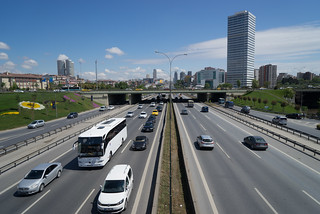Turkey’s economy has transformed over the past few decades. In 1960, according to the World Bank, the country’s GDP per capita was just over $250 – roughly the level of the poorest country on earth today. Now the average Turk is more than 40 times wealthier, and the country is, by many standards, a developed nation. The past decade has been particularly prosperous, with the economy more than doubling. And as we’ve traveled around Istanbul, we’ve seen signs everywhere of this growth: new buildings, packed shopping malls, and new roads.
Unsurprisingly, energy consumption has also increased many times, and greenhouse gas emissions have increased by more than 20-fold since 1960. And there’s still room to grow – the average Turk still uses about one fifth as much electricity as the average U.S. citizen, and emissions per person are much lower than in most wealthy countries.
What does the future look like? Will emissions keep climbing? How can a country like Turkey keep increasing the wealth of its citizens, yet also cut greenhouse gases?
To answer these questions, while in Istanbul Lindsey and I spoke with Adonai Herrera-Martínez of the European Bank for Reconstruction and Development (EBRD). The bank, a public institution, was founded in the early 1990s, largely to help former Soviet countries transition to market economies. Unlike other multilateral public banks (such as the World Bank), the EBRD provides financing largely for the private sector. Adonai is the Principal Manager for Energy Efficiency and Climate Change, and his projects help industries reduce their greenhouse gas emissions.
According to Adonai, the next decade in Turkey may look very different from the past decade. In the past decade, the growth in electricity consumption was supplied largely by coal or natural gas. In the next decade, the government plans for gas and coal to continue to play a role, but also intends for almost half of the new capacity will be provided by wind power. In other words, according to this official plan, natural gas will grow more slowly, and renewables other than hydropower – of which there are barely any today – will jump upward on the graph below.
The reason, Adonai explained, is twofold. First, and most importantly, the government wants to be “energy independent” and reduce its exposure to foreign markets (although the country does have coal reserves, so it may increase coal while decreasing natural gas use). Second, because Turkey is considering joining the European Union, and because the EU requires its members to set emissions targets, Turkey must develop such targets. Thus, through a combination of a desire for energy independence and pressure from the international community, renewables have a bright future in Turkey. This is, though, only a government projection and goal – whether or not it is met depends on many factors.
But even if the government meets these targets, Turkey’s emissions will continue to rise. In the best-case scenario, emissions will rise “only 30 percent” by 2030. And this is, I think, what success looks like in the next decade or two: Emissions from rapidly developing countries grow much more slowly, even though their economies continue to grow quickly. (Although Turkey’s per capita emissions will still be far below that of the United States.) In the long run, though, we need to figure out how to grow economies and decrease emissions.
Below are two videos of me talking with Adonai. The first is an interview, and the second is a longer, more informal discussion on energy issues and development.








I’m glad that’s not the elevation profile of your ride.